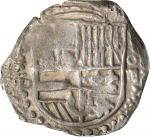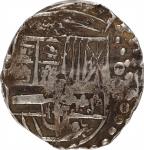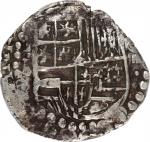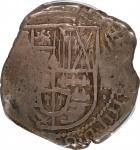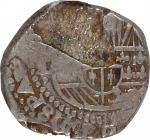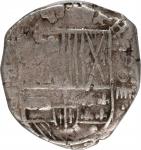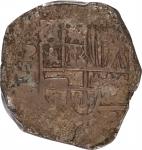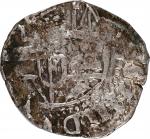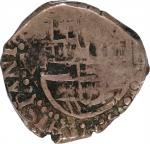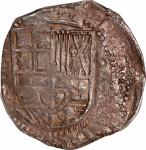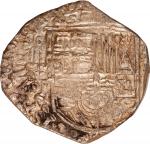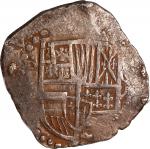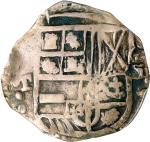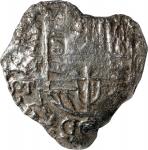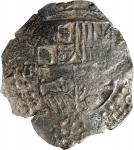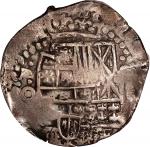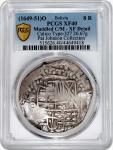BOLIVIA. Cob 8 Reales, ND (1649)-P. Potosi Mint; Assayer Juan Rodriguez de Rodas (O). Philip IV. PCGS EF-40; Countermark: EF Details--Muddled.KM-19B; Cal-Type-321; Paoletti-240. Weight: 26.67 gms. This 8 Reales piece is visually stunning and highly interesting. The coin displays evidence of two or three strikes, each slightly shifted, on both sides of its broad flan. The obverse mintmark is slightly corrupted but quite distinguishable, and the assayers monogram beneath it is rather clear. Though the denomination mark on the right is unfortunately obscured, the Habsburg shield in the center is presented rather fully, albeit sloppily. The reverse legend is mostly botched, but displays the full word "INDIA" as well as "ANO" followed by the digit "4", which is enough to confirm the coins mintage year. The central castles and lions, distorted by the multiple strikes, are further obfuscated by a countermark meant to retariff the coin to nominal value of 7 1/2 Reales. This piece, a testament to a fascinating turning point in numismatic history, is destined to see spirited bidding due to its impressive eye appeal and historical interest. <p><em>Although Spain had succeeded in turning her vast production of silver cobs from Potosi into a global currency, troubling rumors about their true silver content began to swirl in the first part of the 17th century. By the 1640s, this debasement was so widely known that Potosi coins were being called "</em>Rochunas<em>", in reference to the Corregidor of Potosi, Francisco Gomez de la Rocha, and often rejected in trade. This escalated into a crisis, with neighboring countries, including Portugal, officially halting the admission of Potosi-produced Reales into circulation. The dire situation forced the Spanish Crown to take action: in 1648, they sent the inquisitor Francisco de Nestares Marin to investigate the fraud and expose the perpetrators. By the following year, Marins investigation had uncovered an expansive conspiracy, with at least 119 individuals implicated and convicted. Several guilty parties, among them Gomez de la Rocha himself, were publicly executed by strangulation. The Crown then sent Juan Rodriguez de Rodas directly from Spain to take charge of the Potosi mint as head assayer. The curious monogram with which Rodas signed the new issues, a dot within a circle, may have been a pun hinting at the similarity of Rodas name with the Spanish word for wheels, </em>ruedas<em>. Unfortunately, the new emissions still fell short of the Crowns standards for fineness, and were thus retariffed with a countermark to a corrected value of 7 1/2 Reales. The great mint scandal at Potosi had wide-ranging numismatic consequences, including the complete redesign of cob coinage three years later and the eventual reopening of the Lima mint.</em><p><p><strong>To view all items from the Pat Johnson Collection, click <a href="https://auctions.stacksbowers.com/lots?sort=auction_date_lot_number_asc&search=From+the+Pat+Johnson&limit=96&parent_category=1-11EIV&lots_range=upcoming"> here.</a></strong>From the Pat Johnson Collection.

